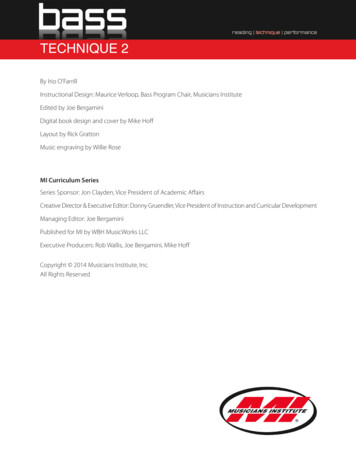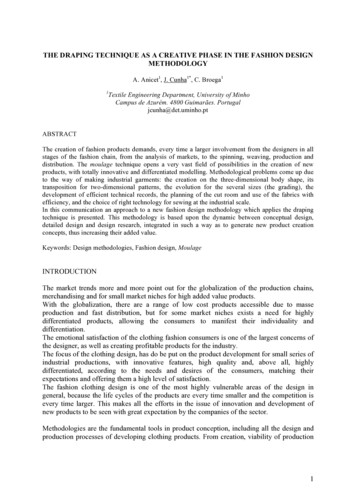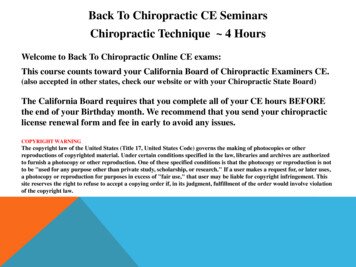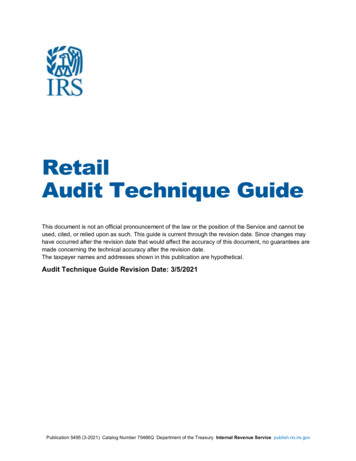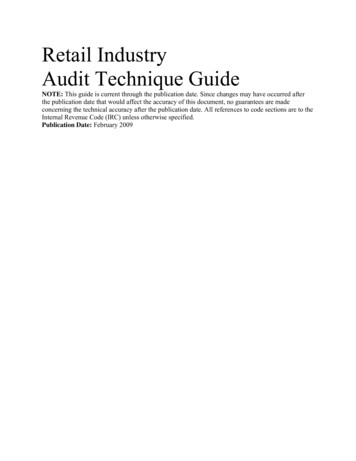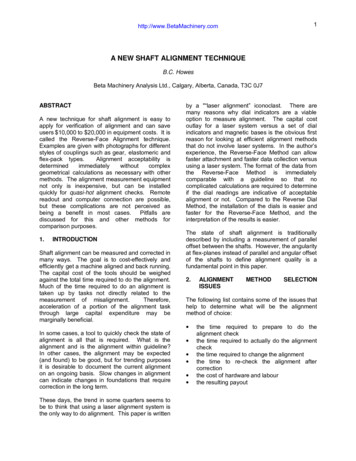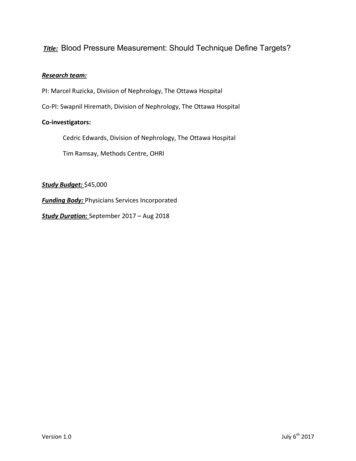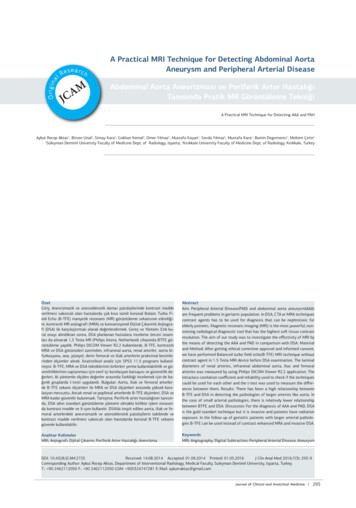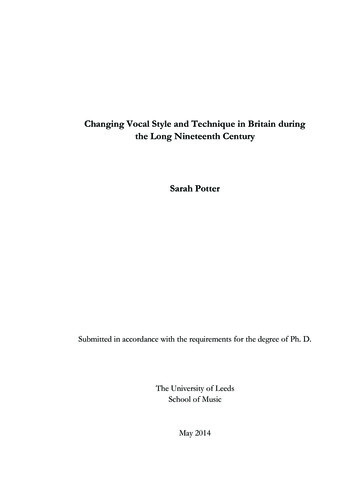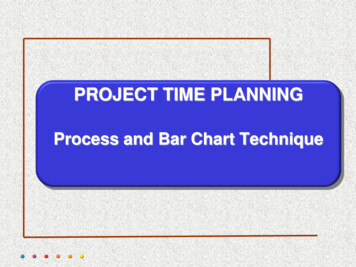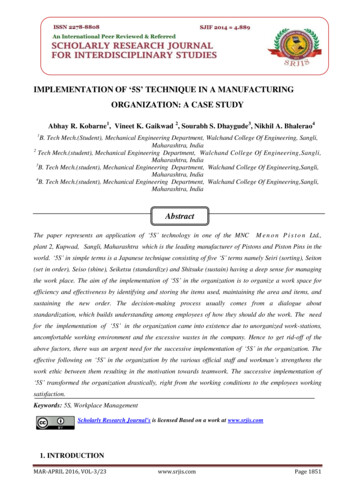
Transcription
SRJIS/BIMONTHLY/ ABHAY R. KOBARNE & Others (1851-1872)IMPLEMENTATION OF ‘5S’ TECHNIQUE IN A MANUFACTURINGORGANIZATION: A CASE STUDYAbhay R. Kobarne1, Vineet K. Gaikwad 2, Sourabh S. Dhaygude3, Nikhil A. Bhalerao41B. Tech Mech.(Student), Mechanical Engineering Department, Walchand College Of Engineering, Sangli,Maharashtra, India2Tech Mech.(student), Mechanical Engineering Department, Walchand College Of Engineering,Sangli,Maharashtra, India3B. Tech Mech.(student), Mechanical Engineering Department, Walchand College Of Engineering,Sangli,Maharashtra, India4B. Tech Mech.(student), Mechanical Engineering Department, Walchand College Of Engineering,Sangli,Maharashtra, IndiaAbstractThe paper represents an application of ‘5S’ technology in one of the MNCM e n o n P i s t o n Ltd.,plant 2, Kupwad, Sangli, Maharashtra which is the leading manufacturer of Pistons and Piston Pins in theworld. ‘5S’ in simple terms is a Japanese technique consisting of five ‘S’ terms namely Seiri (sorting), Seiton(set in order), Seiso (shine), Seiketsu (standardize) and Shitsuke (sustain) having a deep sense for managingthe work place. The aim of the implementation of ‘5S’ in the organization is to organize a work space forefficiency and effectiveness by identifying and storing the items used, maintaining the area and items, andsustaining the new order. The decision-making process usually comes from a dialogue aboutstandardization, which builds understanding among employees of how they should do the work. The needfor the implementation of ‘5S’ in the organization came into existence due to unorganized work-stations,uncomfortable working environment and the excessive wastes in the company. Hence to get rid-off of theabove factors, there was an urgent need for the successive implementation of ‘5S’ in the organization. Theeffective following on ‘5S’ in the organization by the various official staff and workman’s strengthens thework ethic between them resulting in the motivation towards teamwork. The successive implementation of‘5S’ transformed the organization drastically, right from the working conditions to the employees workingsatisfaction.Keywords: 5S, Workplace ManagementScholarly Research Journal's is licensed Based on a work at www.srjis.com1. INTRODUCTIONMAR-APRIL 2016, VOL-3/23www.srjis.comPage 1851
SRJIS/BIMONTHLY/ ABHAY R. KOBARNE & Others (1851-1872)Every organization aims for profit. In today‟s global market of decreasing profit margins, the profitmade from the waste as well as through proper workplace management is mandatory. Thus it isdirectly related to the competition of the particular organization with the competitor. Hence theprofit from the waste and through the proper workplace management can be made only whenthere will be a stringent implementation of some workplace management technique and thattechnique is „5S‟ concept.Also the Menon Piston Ltd., Sangli aims for building it to a world-class levelorganization.Thus organization adopted the concept of „5S‟ for enhancing the profit, class of the company,working conditions, etc. and implemented the„5S‟ technique successfully. Also the organization have various departments such as assembly,stores, injection moulding, maintenance and tool room, administration where the implementation of„5S‟ would result in a huge enhancement in productivity, proper workplace condition, increasedprofits and motivation to employees.1.1 What Is ‘5S’?„5S‟ is one of the Japanese techniques which was introduced by Takashi Osada in the early 1980s[2]. It is basically a workplacemanagementmethodologywhichhelpsfor improvingworking environment, human capabilities and thereby productivity [6]. The word „5S‟ representsthe 5 disciplineformaintainingvisualworkplace.„5S‟is workplace management tominimize the loss of time and unnecessary movements as well. It comprises 5 principles in makingthe organization highly efficient and effective those are:Seiri: - (sorting)1. Perform sorting activity at your workplace i.e. into wanted and unwanted things.2. Remove all the unwanted things that are at your workplace.3. Only keep those things that you need.Seiton: - (set in order)1.Decide place for everything that you need.2.Give proper identification to it for ease of search.3.Keep everything at its defined place after use.4.Make sure every time that everything is at its place.Seiso: - (shine)1.Always keep cleanliness at your workplace.2.Keep the tools always clean after its use.3.Areas should be properly marked or painted.MAR-APRIL 2016, VOL-3/23www.srjis.comPage 1852
SRJIS/BIMONTHLY/ ABHAY R. KOBARNE & Others (1851-1872)Seiketsu: - (standardize)1.Define standard method/way of doing the work i.e. prepare standard operating procedure(SOP).2.Do the work in that method/way only.3.Maintain the discipline in your work [5].Shitsuke: - (sustain)1.Maintain consistency in the method of doing work [3].2.Stick to the „5S‟ rules for proper workplace management.3.Encourage the participation of all, for consistency in „5S‟ activities.4.Perform „5S‟ activities periodically.1.2 Organization IntroductionMenon Piston Ltd, Maharashtra, India inaugurated in 1969 MPL is a total engineering solutionprovider wherein the product is designed as per the customerrequirements, prototype aremanufactured, tested and validated before mass production.MPL group is specialized in manufacturing of pistons, piston rings, piston pins and bearings aswell. The products are manufacture at various locations depending upon the availability of skilledlabours and logistics benefit.2. Problem StatementThe following problems occurred before implementation of „5S‟ in the organization:1.Improper utilization of storage space for raw material, bins and finished products.2.Wastage of time in searching the raw material due to non-permanent location for storage ofraw material.3.Low productivity due to the time wastage in searching for tools, materials due toimproper workplace management.4.Presence of unwanted materials at the workplace which affects the moral of the workerwhile working.5.Useful storage space being acquired by the unwanted materials.6.More time and cost required for the inventory process of unwanted stored materials in rawmaterial stores.7.No well defined space for storing the unwanted or rejected material.8.Unequal participation of officers and workers in workplace management due to nonstandardization.MAR-APRIL 2016, VOL-3/23www.srjis.comPage 1853
SRJIS/BIMONTHLY/ ABHAY R. KOBARNE & Others (1851-1872)3. METHODOLOGYThe following method was adopted to implement „5S‟:1. To create awareness among the employees for the implementation of „5S‟, various awarenessprograms and presentations were undertaken by the various experts in the organization. Also theofficial staff visited the leading organization‟s in which „5S‟ had already being implementedsuccessfully.2.As the organization consist of various departments it was difficult and impossible to implydirectly the „5S‟ technique in the organization. Hence the organization was simplifiedintovarious zones consisting of specific departments along with it, the zone leaders and subzone leaders were also appointed. The organization was simplified as:Table 1: Simplification of organizationZonesSub-Zones1. Parking and Main Gate2. Gate House3. Gardening and Perifery road2. Store Room1. Raw material room1. Vendor Section2. Heating and casting3. Heat Treatment3. Inspection lab4. Maintnance Room1. Centreless Grinding machines( No. 1,2,3)2. CNC Section4. Machine Shop3. Packing Section4. Quality control lab1. Plant head office5. Office2. HR OfficeNow as the organization was simplified into different zones, the „1S‟ activity was1. Peripheri3.undertaken by the respective zones under the guidance of respective zone leaders.4.After the implementation of „1S‟ in various zones, the audit was conducted by the apex teamof the organization. Then the queries raised from the audit by the apex team were taken intoconsideration by the respective zones and the corrective measures were taken on it.3.1 Pre-Audit reportAs need for implementation of 5-S a pre-audit was conducted in foundry and checklist was preparedfor concerned departments showing layout of shop, useful and unnecessary items. On the basis ofpre audit, different problems are found out and necessary solutions are suggested.MAR-APRIL 2016, VOL-3/23www.srjis.comPage 1854
SRJIS/BIMONTHLY/ ABHAY R. KOBARNE & Others (1851-1872)3.1.1 Maintenance department (Zone 1)3.1.1 (A) Layout178624351-Maintenance rack 1, 2-Maintenance rack 2, 3-Supply panel, 4-Lockers,5-Entry, 6-Incharge section, 7-Maintenance Files, 8-Nut and Bolt sectionFig 1 Layout of maintenance Department3.1.1 (B) Checklist for Maintenance roomTable 2 Checklist for Maintenance roomSr.Check list for step S1 (sorting)No.1Are there any useless things that can bother your work environment?YesNoYesAre there any useless raw materials, semi-finished products and/or waste2Yesleft as is, nearby workplace?Are there any tools, spare parts, materials left on the floor, nearby34Yesequipment?Are all frequently used objects sorted, arranged, stored and labelled?NoAre all measurement instruments/devices sorted, arranged, stored and5Nolabelled?MAR-APRIL 2016, VOL-3/23www.srjis.comPage 1855
SRJIS/BIMONTHLY/ ABHAY R. KOBARNE & Others (1851-1872)3.1.2 Purchase and store Department (Zone 2)Date: 15 Feb, 20163.1.2 (A) Layout1234651-Inspection of incoming material, 2-Supervisor Cabin, 3-4-5- Raw material, 6- Tray sectionFig 2 Layout of purchase and store department3.1.2 (B) Checklist for purchase and store roomTable 3 Checklist for purchase and store roomSr.No.1Check list for step S1 (sorting)Are there any useless things that can bother your work environment?Yes NoYesAre there any useless raw materials, semi-finished products and/or waste2Noleft as is, nearby workplace?Are there any tools, spare parts, materials left on the floor, nearby34Noequipment?Are all frequently used objects sorted, arranged, stored and labelled?NoAre all measurement instruments/devices sorted, arranged, stored and5Nolabelled?Does the inventory or in-process inventory include any unneeded6Nomaterials or parts?7Are there any unused machines or other equipment around?Yes8Are there any unused jigs, tools, dies or similar items around?Yes9Is it obvious which items have been marked as unnecessary?Yes10Has establishing the 5S's left behind any useless standards?YesMAR-APRIL 2016, VOL-3/23www.srjis.comPage 1856
SRJIS/BIMONTHLY/ ABHAY R. KOBARNE & Others (1851-1872)3.2 Actual Department wise implementation3.2.1 Maintenance department (Zone 1)3.2.1 (A) Problem StatementsThe following problems occurred before implementation of „5S‟ in the organization: Wastage of time in searching the raw material due to non-permanent location for storage ofraw material. Low productivity due to the time wastage in searching for tools, materials due to improperworkplace management. Presence of unwanted materials at the workplace which affects the moral of the worker whileworking. Useful storage space being acquired by the unwanted materials. More time and cost required for the inventory process of unwanted stored materials in rawmaterial stores. No well defined space for storing the unwanted or rejected material. Unequal participation of officers and workers in workplace management due to nonstandardization.3.2.1 (B) Formation of 5S CouncilObjective of this is to enhance total participation at all levels of employees and develop acontinuous improvement culture and best performance spirit in the teams.5S Council comprises the following: 5S Steering Committee Managing Director as Advisor General Manager as Chairman Head of Departments as Facilitators 5S Training Committee 5S Promotion Committee 5S Audit g 3 5S CouncilMAR-APRIL 2016, VOL-3/23www.srjis.comPage 1857
SRJIS/BIMONTHLY/ ABHAY R. KOBARNE & Others (1851-1872)3.2.1 (C) Employee trainingThis training programme, which is the starting point of 5S: Step-by-Step Implementation,encourages workers to become actively involved in the application exercises. This is theresponsibility of the 5S Training Committee.Once the preliminary training is completed, everyone will have the required basic knowledge, andbe responsible for action in progress. Plans describing implementation of the 5S phases must beprepared and released during the 5S declaration.The most common mistake organizations make when implementing the 5S system, is the failure totrain adequately at the outset. Training should proceed as follows: 5S Awareness for Top Management 5S Awareness for Operators Step-by-Step 5S Implementation for Facilitators Step-by-Step Internal 5S AuditWe have given training of 5S to top management, lower management and workers as well.Following are the some photographs of training programme.Fig 4 Vendor‟s trainingFig 5 Vendor‟s TrainingFig 5 Training of maintenance department employeesMAR-APRIL 2016, VOL-3/23www.srjis.comPage 1858
SRJIS/BIMONTHLY/ ABHAY R. KOBARNE & Others (1851-1872)3.2.1 (D) Implementation of Seiri and Seiton:Sorting aims for removing all the unwanted materials from the workplace. After sorting theunwanted materials from the workplace, they are placed in the red tag area and the details of it arenoted down on the red tag card. ( as shown in Fig 6 ) The materials noted down on the red tag cardare then moved to scrap yard or located properly or rectified or segregated or returned to thesupplier based on the decision of apex team and zone leader.Set in order aims at “place for everything and everything in its place” [2]. After sorting, the specificlocation is defined for the useful material and located in the predefined order.Front sideBack sideFig 6 Example of Red tagFig 7 Red tagging to materialsMAR-APRIL 2016, VOL-3/23Fig 8 Red tagging to wastagewww.srjis.comPage 1859
SRJIS/BIMONTHLY/ ABHAY R. KOBARNE & Others (1851-1872)Above pictures shows red tagging to the various kinds
As need for implementation of 5-S a pre-audit was conducted in foundry and checklist was prepared for concerned departments showing layout of shop, useful and unnecessary items. On the basis of pre audit, different problems are found out and necessary solutions are suggested. SRJIS/BIMONTHLY/ ABHAY R. KOBARNE & Others (1851-1872) MAR-APRIL 2016, VOL-3/23 www.srjis.com Page 1855 3.1.1 .
